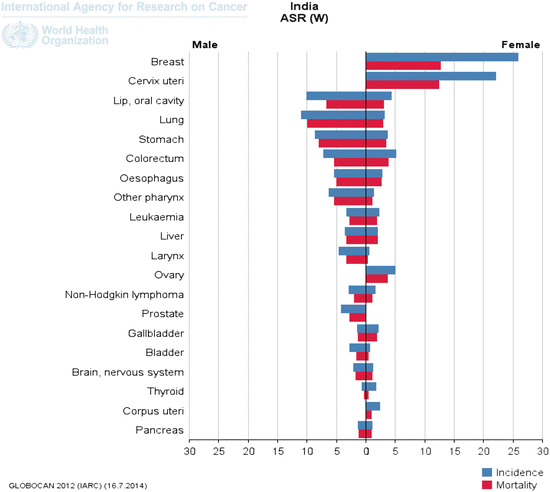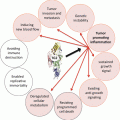Fig. 10.1
Estimated age-standardized rates (world) per 100,000 incidence and mortality of cancer in more and less developed countries (GLOBOCAN 2012)
10.2 Indian Scenario
With an estimated burden of over one million individuals diagnosed with cancer in India in 2012, malignancy is a key issue. The three most commonly occurring cancers in India are those of the breast, uterine cervix, and lip/oral cavity, together accounting for approximately 34 % of all cancers as shown in Fig. 10.2 (Ferlay et al. 2013). Understanding and implementing Indian-specific workable strategies for screening for preventable cancers is the need of the hour.


Fig. 10.2
Estimated age-standardized rates (India) per 100,000 incidence and mortality of top 20 cancers in males and females (GLOBOCAN 2012)
10.3 Current Status of Cancer Screening Activities in India
10.3.1 Cervical Cancer
One in 53 Indian women in their lifetime develops cervical cancer, compared to one in 100 in developed countries (Dikshit et al. 2012). In spite of cervical cancer being largely a preventable disease, 72,825 women die every year in India (Ferlay et al. 2013). Papanicoloan (Pap) smear-based screening programs in India are ill-equipped to effectively provide screening to all women as they are faced by the challenges of the high cost of the test, paucity of trained cytopathologists, difficulty in reaching target populations, carrying out appropriate testing, difficulties in following up of screen-positive women, absence of quality assurance measures, and poor health-care infrastructure. Moreover, a multicenter screening study in India concluded that the sensitivity of cytology varied widely between various sites within India (Bhaumik 2013).
Of the available visual screening tests, visual inspection using acetic acid (VIA) has been most widely investigated and accepted as a potential alternative to cytology in low resource settings. VIA has been shown to have a sensitivity ranging from 67 % to 90 % (Sankaranarayanan et al. 1998, 2004; Shastri et al. 2005) and has several advantages over cytology:
Low cost and readily available.
Large population coverage.
It can be performed by a trained health-care personnel.
Does not require electricity or laboratory equipments.
Provides immediate results which allows treatment at the same sitting.
There are few limitations of this test:
VIA is a subjective test and accuracy is dependent on the skill of trained provider.
Not suitable for postmenopausal women where the squamocolumnar junction moves inward.
Mittra et al. carried out a population-based randomized controlled trial comparing the effectiveness of cytological screening, testing for human papillomavirus (HPV) infection, and VIA in reducing the incidence of and mortality from cervical cancer in rural India (Mittra et al. 2010). This study concluded that VIA screening by primary health workers reduced cervical cancer mortality.
Another study assessed the efficiency of single round of VIA screening on cervical cancer incidence and mortality in 114 study clusters in Dindigul district (Sankaranarayanan et al. 2007). Screen-positive women underwent colposcopy, directed biopsies, and, where appropriate, cryotherapy by nurses during the screening visit. This study concluded that VIA screening, in the presence of good training and sustained quality assurance, is an effective method to prevent cervical cancer in developing countries. An appropriate use of this approach can make cervical cancer control a reality in India.
An Expert Committee Meeting was held in November 2005 in the Department of Cytology and Gynecologic Pathology, Postgraduate Institute of Medical Education and Research, Chandigarh, to develop national guidelines for undertaking cervical cancer screening through the existing health system (2006). It was proposed that the Cervical Cancer Screening Program should be started as demonstration programs in settings that can take up the load of screening women in large numbers. The proposed strategy planned to cover women in the age group of 30–59 years starting at the Primary Health Centres. The District Cancer Control Programme under the National Cancer Control Programme could be a good avenue to pilot this screening strategy. But, very few states had initiated the program either due to lack of resources or poor infrastructure.
HPV DNA testing is an objective test and has good reproducibility, and requires training, thus making it suitable for developing countries such as India. The sensitivity of this test is higher than the other methods and falls in the range of 66–95 % while the specificity is between 76 % and 95 %. However, HPV DNA test has few limitations which include the cost factor, complexity of interpretation (8 h for Hybrid Capture 2), and need to confirm persistent HPV infection with repeated tests 6–12 months apart, and it cannot be used in women less than 30 years of age due to spontaneous regression of most HPV infections in younger age groups. Recently, the U.S. Food and Drug Administration (FDA) has approved cobas HPV test® as a primary cervical cancer screening test which detects DNA from 14 high-risk HPV types. The development of new simpler, accurate, and cost-effective kits for HPV DNA such as CareHPV (portable, less interpretation time of 2.5 h, low cost and accurate) could make HPV DNA a promising screening strategy for developing countries (Qiao et al. 2008).
10.3.2 Breast Cancer
Breast cancer has emerged as one of the leading sites of cancer among women in India with an incidence of 25.8/100,000 (Ferlay et al. 2013). The number of women detected with breast cancer in India in 2012 was 70,218 and is expected to cross the figure of 100,000 by the year 2020 (Takiar et al. 2010). The 5-year relative survival for breast cancer ranges from 76.3 % for localized cancers to 14.9 % for advanced stage disease (Sankaranarayanan et al. 2010). Early detection improves both treatment and economical outcomes (Sankaranarayanan et al. 2011). The currently available screening modalities for breast cancer include breast self-examination (BSE), clinical breast examination (CBE), mammography, and ultrasonography.
BSE is a simple, cost-effective method of teaching women and creating awareness about breast. However, two large randomized trials did not demonstrate a mortality benefit from teaching breast self-examination (Thomas et al. 2002; Semiglazov et al. 1992). BSE has been shown to increase the detection of benign lesions and, therefore, is not recommended as a public health screening method (Corbex et al. 2012).
The sensitivity and specificity of CBE is reported to be 54 % and 94 %, respectively, in a review of controlled trials and case–control studies. A cluster-randomized controlled screening trial for breast cancer using trained primary health workers to provide clinical breast examination in the screening arm and only health education in the control arm is ongoing (Mittra et al. 2010). At the completion of three rounds, there was significant downstaging of breast cancer in the screening arm when compared to control arm (p < 0.004).
Developed countries have adopted mammography for routine screening of breast cancer and have shown substantial reduction in mortality from breast cancer, especially in women over the age of 50 years. A meta-analysis of 13 randomized trials found a 26 % reduction in the relative risk of breast cancer-related mortality when women 50–74 years of age received screening mammography (Nyström et al. 2002). Reported sensitivity ranges from 64 % to 90 % and specificity from 82 % to 93 % (Elmore et al. 2005). Breast cancer screening programs involving imaging techniques are expensive and for this reason cannot be made available as a routine public heath measure in developing countries.
Recently, scintimammography, magnetic resonance imaging, positron emission tomography, ductal lavage, and thermography have been considered as possible tools for breast cancer screening (Heywang et al. 2013; Ribeiro et al. 2013; Kishore et al. 2006). However, also they lack validation in prospective trials.
10.3.3 Oral Cancer
Oral cancer is the third most common cancer in India, following malignancy of the breast and cervix (Ferlay et al. 2013). Among the males, tobacco-related cancers are expected to be 225,241 (42 % of all sites cancers) by the year 2020 (Takiar et al. 2010). Tumors of the oral cavity can be detected early and every opportunity should be exploited to detect precancerous conditions or cancers of the oral cavity, specially in those who consume tobacco. Avoidance of tobacco and alcohol is the most important preventive action against oral cancers. As oral cancers are mostly found in developing countries, there are no international standards of methods or practices for early detection.
Simple oral visual examination (OVE) with adequate light is the most commonly used and established screening method for the early detection of precancerous lesions of the oral cavity, e.g., leukoplakia, erythroplakia, nonhealing ulcers, and oral submucous fibrosis. The overall sensitivity and specificity for OVE is 85 % and 95 %, respectively.
Stay updated, free articles. Join our Telegram channel

Full access? Get Clinical Tree








